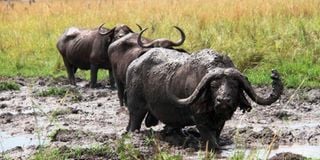Exploring Ruma National Park

Buffalos take mud bath at Ruma National Park.
It was our last full day on Rusinga Island, and we had decided to make our first-ever visit to the Ruma National Park. It was also a day we were reminded that the shortest route to somewhere need not be the quickest – or the easiest.
We were faced with a choice: drive back along the smooth tarmac of the road from Homa Bay to Mbita, and after about 30 kilometres take the signposted murram road to Ruma – or take the shorter route of a dirt road that skirted Lake Victoria as far as Sindo, and then bear left to the park.
We chose the shorter and the way less travelled by. It was a mistake. Even in our Defender, the road was a challenge. There were parts that had been almost washed away; there were deep ruts to be avoided and craters to be negotiated. It was a fun ride for the many boda boda riders along the way. For a time, we followed a little Probox taxi, the intrepid driver of which must have been very familiar with all the hazards.
But there were consolations – the colourful small boats moored in the fishing villages, the mats spread with omena fish (the Lake Victoria sardine) to dry in the sun, and the many cows contentedly warming their bellies on the road.
And then Ruma – the only national park in Nyanza. It is not as well-known and, no doubt, it is much less visited than most of our parks and reserves. But it has a magnificent setting: in the Lambwe Valley and surrounded by dramatic mountains. The KWS official guidebook describes it as ‘an island of wilderness in a sea of intense cultivation’. Its best claim to fame is that it has a sanctuary for one of Africa’s rarest animals – the Roan antelope.
By the time we got to the park it was 11.00am, and at the gate they told us that the antelopes were deep in the trees in their fenced-off sanctuary, and it would be better to try to find them later in the afternoon. We did return, but eventually we had to give up, because we wanted to get back to Rusinga Island before dark.
We had very much enjoyed our drive around the main park. At one point, we saw a flock of crowned cranes landing in front of us. As we rounded a bend, we came to a swampy area where the cranes had landed. There was a herd of buffalos enjoying a wallow in the mud. Many of them had tick-hunting egrets on their backs.
Another highlight was a new entry for our bird list: a bare-faced go-away bird, that is mainly found in Kenya only in the south-west. We also saw a number of Rothschild’s giraffes, which are mainly found in parts of western Kenya.
Ruma is classic savannah country, so there are lots of plains game to be seen – zebra, wildebeest, impala, and it is one of the few places where you can see the Jackson’s hartebeest. A rhino surprised us, too, as it emerged from the long grass close to the road. There are patches of riverine woodland, where there are leopards – but not so easily seen.
But it was good just to be in such a wild country, surrounded as it is by small farms. For Ruma Park’s existence, we have to thank tsetse flies. They used to be such a scourge that the land was left uncultivated. There are not so many in the park now – though one took a ride on our windscreen.
For overnighting, Ruma has the self-catering Oribi Guest House and the Nyati campsite – both near the Kamato Gate. (For reservations, go to www.kws.go.ke.) But we needed to leave. And which route did we take back to Rusinga Island? The longer and quicker one, of course.
John Fox is Chairman of iDC Email: [email protected]





